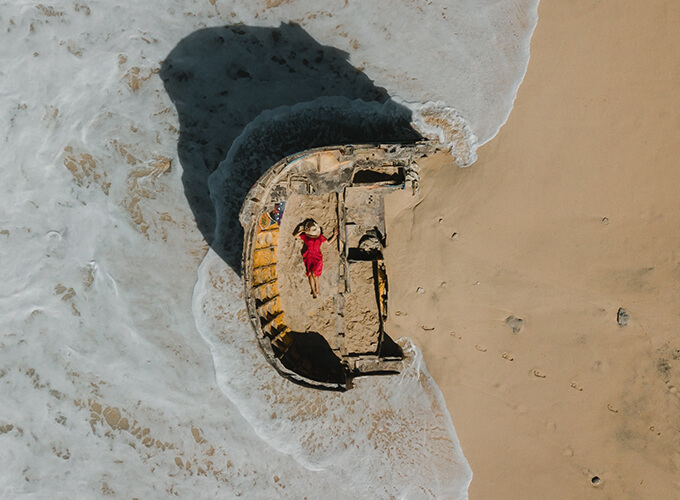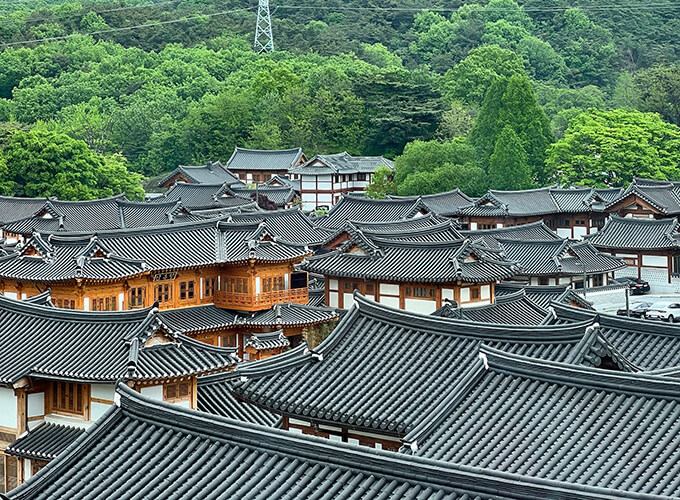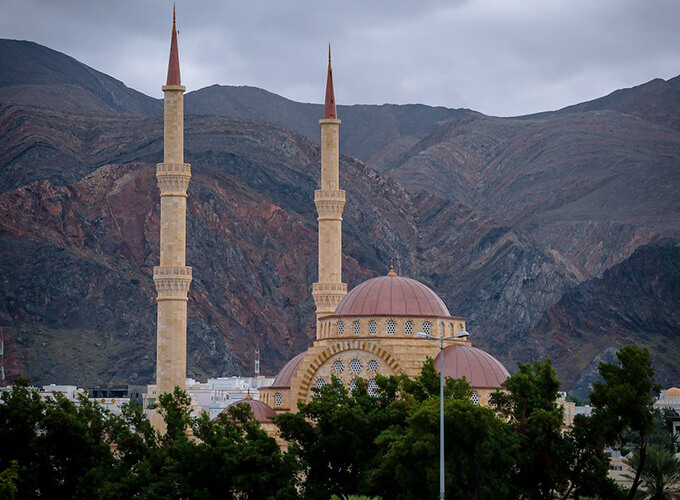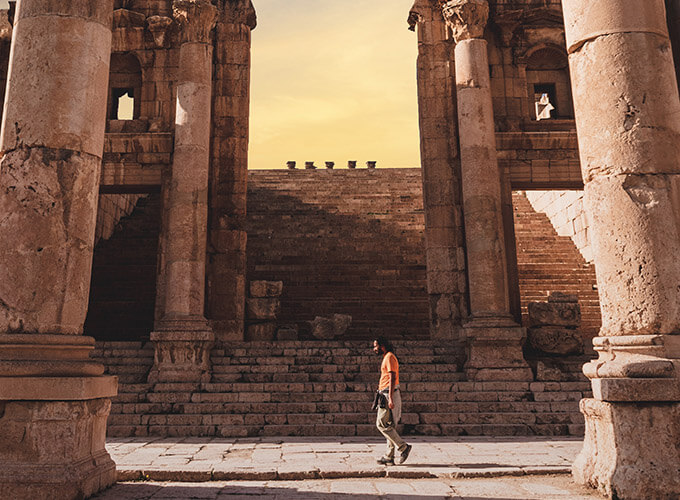Crossing borders: Korea to Kyushu
Besides close geographical proximity South Korea and Japan share many similarities and make natural holiday partners. Both are countries rich in ancient history, where deep-rooted traditions are balanced by contemporary culture and technological sophistication. Natural wonders and scenic beauty can be found throughout the two, as can a distinctive cuisine and friendly people. This ten day itinerary offers a teasing taster of both destinations.
Highlights
- Discover Seoul, the city where K-pop and palace dynasties unite
- Explore the ancient tombs of Tumuli Park in Gyeongju
- Visit Busan, the little known beach destination of South Korea
- Explore Fukuoka's Shofukuji Temple, the first Zen temple to be built in Japan
- Taste ramen at the yatai - open-air food stalls in Fukuoka

Seoul, Gyeongju, Busan, Fukuoka
Sample Itinerary
Upon arrival in Seoul you will be met by your driver and transferred to your hotel. The remainder of your day is at leisure. The capital of South Korea, Seoul is a sprawling metropolis that, like Tokyo, has enjoyed rapid post war expansion and is now one of the most densely populated places in the world. A 24-hour city of glittering skyscrapers, searing neon and K-pop culture; Seoul is also conversely an ancient city of tradition where Buddhist temples, Joseon dynasty palaces and wooden ‘hanok’ houses share the space.
After breakfast, meet your guide and set off to tour some of Seoul’s highlights - visiting the classic and the contemporary. The quickest, most convenient way to travel around the city is by subway and, in true local style; this is predominantly how you will get around during the day. Your first stop of the morning is Gyeongbokgung Palace – the largest of the five Grand Palaces and the main palace of the Joseon dynasty (the last monarchy in Korean history). Built in 1395, the palace has endured fire and years of abandonment, survived Japanese occupation and Korean War, yet it remains one of the most beautiful palaces in the country. Arrive in time for a behind-the-scenes glance at the royal guards in traditional costume rehearsing before the changing of the guards ceremony which takes place at the main gate at 10am. Following the ceremony, venture inside the palace walls and explore the grand, opulent palace interiors. It’s an interesting insight into how life must have been for Korean royalty in their heyday. In complete contrast, a ten minute walk will lead you to Bukchon Hanok Village: home to around 900 traditional wooden homes that date back to the Joseon dynasty. Traditionally built using natural materials (predominantly wood and clay), with distinctive curved roofs, many of these hanoks still provide housing for Seoulites; others have been converted into guesthouses, restaurants and tea houses. Stroll through the narrow streets and alleyways, stopping for lunch, where you will have the opportunity to try Bibimbap – a well-known South Korean one-pot wonder. After lunch, visit Jongmyo Shrine, one of Seoul’s three UNESCO World Heritage Sites. Jongmyo is the oldest and best preserved royal Confucian shrine, housing ‘spirit tablets’ (plaques inscribed with ancestral names) of the kings and queens of the Joseon dynasty. Confucian rituals and cultural performances continue to take place here. Continue on to Gwangjang Market, which is one of the largest and oldest traditional markets in the country, dating back to the early 1900’s. Packed with stalls selling everything from vintage clothing to vegetables it’s arguably the best place in Seoul for Korean street food. The Bindaetteok (mung bean pancakes) are well worth sampling. Final stop of the day is N Seoul tower – the highest point of Seoul - from where you can enjoy panoramic views over the city. Return to your hotel around 5pm, and your evening is at leisure.
After breakfast transfer to Seoul train station in time for the KTX Express train to Gyeongju. Often referred to as South Korea’s cultural heart, Gyeongju was capital of the Silla dynasty for close to a thousand years and is home to more temples and tombs, pagodas and palaces than anywhere else in the country. Upon arrival you will be met by your guide for an afternoon tour of Gyeongju’s historical highlights. Gyeongju is well known for its abundance of ‘tumuli’, huge grassy mounds under which lie ancient royal tombs from the Silla era, and your first stop will be Daereungwon Tomb Complex (also known as Tumuli Park). There are over two dozen large tombs located here, thought to be those of kings and high-ranking officials. The most well-known, and the only tomb you can step inside, is Cheonmachong, which when excavated in the early 1970’s yielded astonishing treasures including a gold crown and impressive horse painting on the tomb walls. Continue on to the 7th century Cheomseongdae Observatory, reputedly the oldest surviving astronomical observatory in Asia. Huge importance was placed on astrology in ancient Korea and it is likely that this observatory was an integral place in the community. A short walk will take you to Banwolseong, the site of the palace fortress during the Silla dynasty and now an attractive park area, where a handful of ruins can still be seen. Finally visit the Donggung Palace & Wolji Pond, which were part of the palace complex. An excavation project in the 1970’s unearthed a treasure-trove of ancient relics beneath the waters, ranging from unique roof tiles to gilt bronze Buddha figures. Proceed to your hotel, check in and the remainder of your day is at leisure.
After an early breakfast check out of your hotel and proceed to Seokguram Grotto. Located on Mount Toham overlooking the Sea of Japan, this 8th century Buddhist cave temple houses a 3.5 metre tall, seated Buddha statue constructed from white granite. The delicately-sculpted statue and surrounding sculptures of bodhisattvas and disciples have been incredibly well preserved and are a designated UNESCO World Heritage Site. From the grotto, walk back downhill to Bulguksa Temple. Built in the 6th century, this Buddhist temple complex comprises of wooden halls, pagodas and shrines on raised stone terraces. It is still to this day a practising place of worship and home to Buddhist monks. Following a tour of the temple, you will have the opportunity to meet and take tea with one of the resident monks. With your guide acting as translator, he will teach you the basics of Cham-Seon meditation and explain the importance of the Da-Seon (tea ceremony). It’s a unique experience and a fascinating insight into the life of a Buddhist monk. After an insightful couple of hours bid farewell to your monastic host and depart Gyeongju heading south towards the seaside city of Busan. South Korea’s second largest city, Busan is famous for its beaches and seafood, and is frequently referred to as ‘Seoul by the sea’, but enjoys a more laid back vibe. Arrive mid-afternoon, check in to your hotel and the remainder of your day is at leisure.
Enjoy a full day tour of Busan. First stop of the day is Beomeosa Temple. Located in a picturesque setting on the slopes of Mt. Geumjeongsan, Beomeosa is one of the largest Buddhist temples in South Korea and is home to around 150 monks. Originally constructed in the 7th century the temple was virtually destroyed by the Japanese in the late 16th century, and most of the present buildings date back to the 17th and 18th centuries. Several of the buildings within the temple complex have been designated National Treasures: notably the One-Pillar Gate, the Three Story Stone Pagoda and the delicately decorated Daeungjeon (main temple hall). Spend some time exploring and soaking up the tranquil atmosphere. In complete contrast your next stop is the Jagalchi Fishery Market, the largest, most popular seafood market in the country. It’s a noisy, frantic place full of tanks containing a mind-blowing array of freshly caught seafood. There’s also a sizeable section dedicated to dried fish. Rather interestingly, most of the vendors are ‘ajumma’ a tough breed of middle aged women. This is a good time to stop for lunch and your guide will be able to recommend a place to eat. Following lunch, make a short stop at the nearby BIFF Square, the original location for the prestigious Busan International Film Festival and now a cultural tourist attraction, before continuing on to the 120-metre high Busan Tower. Take a high speed lift to the viewing deck from where you can enjoy panoramic views over the city. Stunning views can also be enjoyed from your last stop of the day: Taejongdae. At the southernmost tip of the Busan region Taejongdae is allegedly named after King Taejong who enjoyed shooting arrows off the cliffs here. From the rocky clifftops you can enjoy unobstructed views out to sea and on clear days may be able to see Japan’s Tsushima Islands. Transfer back to your hotel, arriving around 5pm.
After breakfast check out of your hotel and transfer to Busan's ferry terminal in time for your hydrofoil to Fukuoka in Japan. On arrival at the port in Fukuoka, 3.5 hours later, having passed through immigration, you will be welcomed by a Selective Asia representative, who will accompany you to your hotel via public transport. Check in and the remainder of your day is at leisure. Situated on the northern shore of the Japanese island of Kyushu, Fukuoka is the largest city on the island, a product of the 1889 merging of the castle town of Fukuoka and the port of Hakata. Due to its proximity to China and Korea (it’s actually closer to Seoul than Tokyo), Fukuoka shares many cultural ties with both countries and has been an important trading post for several centuries.
Your day is at leisure to explore Fukuoka and your My Way Travel consultant can help design the ideal self-guided day, with the tools & freedom to discover the city at your own pace. Begin your day with a morning visit to the Yanagibashi Rengo Ichiba fish market. From its meagre beginnings in 1916 when a single merchant started selling fresh fish, the market is now a bustling hub of activity, popular with local housewives as well as chefs and wholesalers because of the abundance of fresh fish on offer. After lunch, in contrast to the morning market, enjoy the peace and tranquillity of Ohori Park. ‘Ohori’ means ‘moat’ and the park is so named as it was originally part of the nearby Fukuoka castle moat. Today it’s a popular spot for locals looking to relax, take a walk, or jog around the lake. Across the street is the Gokoku shrine, which is easily recognisable with its impressive 13-metre tall torii gate built of Japanese cypress. This shrine was created in remembrance of Japan’s war dead, but is now a popular location for weddings and family ceremonies. Whilst you’re in the area we also suggest visiting the Fukuoka Castle Ruins. Built in the 17th century the castle was the largest on Kyushu, but it was almost completely torn down after the Meiji Restoration and only a few walls and turrets remain. As the sun sets take in the panoramic views over the city and the sea from the observation room of the 234 metre tall Fukuoka Tower.
After breakfast, accompanied by your guide, take the ferry to nearby Nokonoshima Island. Though only a short ferry journey away, this small island has a very different feel to Fukuoka city and is famous for the beautiful flower fields of Nokonoshima Island Park. Each season sees a different variety of flowers and blossoms in bloom, from poppies to cherry blossom; dahlia to sunflowers. Before heading back to the mainland, enjoy the island specialty of kamomedon for lunch - a bowl of rice topped with delicious sashimi, squid and sesame sauce. On your return to Fukuoka city, head to the 12th century Shofukuji Temple, the first Zen temple to be built in Japan. It’s a short walk to nearby Tochoji Temple, which is home to a 33 foot tall wooden statue of Buddha seated on a pedestal. Having visited both temples your guide will accompany you back to your hotel. In the evening we recommend sampling yakitori or Hakata Ramen at Fukuoka's 'yatai' - open air food stalls. Yatai can be found throughout Fukuoka but the best place is on the southern end of Nakasu Island, where there is a long row of yatai located beside the water.
Your day is at leisure to explore Fukuoka’s surrounding regions and your My Way Travel consultant can help design the perfect self-guided day for you. Spend a day visiting nearby Dazaifu, a 30 minute train journey from Fukuoka city. Established in the 7th century, Dazaifu was the location of the Kyushu government for more than 500 years, playing a pivotal role in Japan’s defense and diplomatic relations. This quiet city is home to a number of interesting shrines and temples, the most well-known of which is Dazaifu Tenmangu Shrine. This shrine is particularly important because it was built on the site of the grave of Sugawara Michizane – a revered scholar and politician of the Heian Period. We would also recommend visiting the nearby Komyozenji temple. Established in the 13th century by a member of the Rinzai sect of Japanese Buddhism, it’s especially famous for its two beautiful Japanese gardens. Alternatively, head further afield to Nagasaki.The city of Nagasaki will forever be linked with World War II history and the dropping of a second atomic bomb, however there is so much more to this picturesque city and it’s worthy of a full day visit. It’s a two hour train journey from Fukuoka so we recommend an early start. The Peace Park and sobering Atomic Bomb Museum are essential stops on any trip to Nagasaki. We would also recommend visiting the Glover Gardens where you can see the traditional homes that were built for British merchants and Oura Cathedral – the oldest wooden, gothic-style church in Japan. As dusk falls make your way to the top of Mt Inasa by gondola and take in the famous night views of Nagasaki with the harbour at its centre, surrounded by mountains. Or sample the local specialty of Nagasaki chanpon at the oldest Chinatown in the country before returning to Fukuoka.
Your day is at leisure until making your way to the airport for your onward flight.
Booking Policy
- English speaking, local guide
- All accommodation listed
- Land transportation by private air-conditioned vehicles
- Any domestic flights listed (unless marked otherwise)
- Any train journeys listed (unless marked otherwise)
- All admission fees at attractions, temples and activities as mentioned in the itinerary
- All meals listed (B: Breakfast, L: lunch, D: Dinner)
- Entry visas
- International airport departure taxes
- Any meals not listed in the itinerary
- Drinks, other than water on activity days
- Personal expenses (laundry, telephone, drinks, tip...)
- Travel insurance
- All other services not listed in 'inclusive'













































